Hongzhi Wang
Habin Institute of Technology
Decouple and Orthogonalize: A Data-Free Framework for LoRA Merging
May 21, 2025Abstract:With more open-source models available for diverse tasks, model merging has gained attention by combining models into one, reducing training, storage, and inference costs. Current research mainly focuses on model merging for full fine-tuning, overlooking the popular LoRA. However, our empirical analysis reveals that: a) existing merging methods designed for full fine-tuning perform poorly on LoRA; b) LoRA modules show much larger parameter magnitude variance than full fine-tuned weights; c) greater parameter magnitude variance correlates with worse merging performance. Considering that large magnitude variances cause deviations in the distribution of the merged parameters, resulting in information loss and performance degradation, we propose a Decoupled and Orthogonal merging approach(DO-Merging). By separating parameters into magnitude and direction components and merging them independently, we reduce the impact of magnitude differences on the directional alignment of the merged models, thereby preserving task information. Furthermore, we introduce a data-free, layer-wise gradient descent method with orthogonal constraints to mitigate interference during the merging of direction components. We provide theoretical guarantees for both the decoupling and orthogonal components. And we validate through extensive experiments across vision, language, and multi-modal domains that our proposed DO-Merging can achieve significantly higher performance than existing merging methods at a minimal cost. Notably, each component can be flexibly integrated with existing methods, offering near free-lunch improvements across tasks.
KDSelector: A Knowledge-Enhanced and Data-Efficient Model Selector Learning Framework for Time Series Anomaly Detection
Mar 16, 2025



Abstract:Model selection has been raised as an essential problem in the area of time series anomaly detection (TSAD), because there is no single best TSAD model for the highly heterogeneous time series in real-world applications. However, despite the success of existing model selection solutions that train a classification model (especially neural network, NN) using historical data as a selector to predict the correct TSAD model for each series, the NN-based selector learning methods used by existing solutions do not make full use of the knowledge in the historical data and require iterating over all training samples, which limits the accuracy and training speed of the selector. To address these limitations, we propose KDSelector, a novel knowledge-enhanced and data-efficient framework for learning the NN-based TSAD model selector, of which three key components are specifically designed to integrate available knowledge into the selector and dynamically prune less important and redundant samples during the learning. We develop a TSAD model selection system with KDSelector as the internal, to demonstrate how users improve the accuracy and training speed of their selectors by using KDSelector as a plug-and-play module. Our demonstration video is hosted at https://youtu.be/2uqupDWvTF0.
DistJoin: A Decoupled Join Cardinality Estimator based on Adaptive Neural Predicate Modulation
Mar 12, 2025Abstract:Research on learned cardinality estimation has achieved significant progress in recent years. However, existing methods still face distinct challenges that hinder their practical deployment in production environments. We conceptualize these challenges as the "Trilemma of Cardinality Estimation", where learned cardinality estimation methods struggle to balance generality, accuracy, and updatability. To address these challenges, we introduce DistJoin, a join cardinality estimator based on efficient distribution prediction using multi-autoregressive models. Our contributions are threefold: (1) We propose a method for estimating both equi and non-equi join cardinality by leveraging the conditional probability distributions of individual tables in a decoupled manner. (2) To meet the requirements of efficient training and inference for DistJoin, we develop Adaptive Neural Predicate Modulation (ANPM), a high-throughput conditional probability distribution estimation model. (3) We formally analyze the variance of existing similar methods and demonstrate that such approaches suffer from variance accumulation issues. To mitigate this problem, DistJoin employs a selectivity-based approach rather than a count-based approach to infer join cardinality, effectively reducing variance. In summary, DistJoin not only represents the first data-driven method to effectively support both equi and non-equi joins but also demonstrates superior accuracy while enabling fast and flexible updates. We evaluate DistJoin on JOB-light and JOB-light-ranges, extending the evaluation to non-equi join conditions. The results demonstrate that our approach achieves the highest accuracy, robustness to data updates, generality, and comparable update and inference speed relative to existing methods.
MERLIN: Multi-stagE query performance prediction for dynamic paRallel oLap pIpeliNe
Dec 01, 2024Abstract:High-performance OLAP database technology has emerged with the growing demand for massive data analysis. To achieve much higher performance, many DBMSs adopt sophisticated designs including SIMD operators, parallel execution, and dynamic pipeline modification. However, such advanced OLAP query execution mechanisms still lack targeted Query Performance Prediction (QPP) methods because most existing methods target conventional tree-shaped query plans and static serial executors. To address this problem, in this paper, we proposed MERLIN a multi-stage query performance prediction method for high-performance OLAP DBMSs. MERLIN first establishes resource cost models for each physical operator. Then, it constructs a DAG that consists of a data-flow tree backbone and resource competition relationships among concurrent operators. After using a GAT with an extra attention mechanism to calibrate the cost, the cost vector tree is extracted and summarized by a TCN, ultimately enabling effective query performance prediction. Experimental results demonstrate that MERLIN yields higher performance prediction precision than existing methods.
FREE-Merging: Fourier Transform for Model Merging with Lightweight Experts
Nov 25, 2024



Abstract:In the current era of rapid expansion in model scale, there is an increasing availability of open-source model weights for various tasks. However, the capabilities of a single fine-tuned model often fall short of meeting diverse deployment needs. Model merging has thus emerged as a widely focused method for efficiently building a single model tailored for multiple tasks combined from existing models. Nevertheless, existing model merging methods face challenging trade-offs between performance and deployment costs, primarily due to task conflicts within the merged network. Our analysis of neural networks reveals that some task-specific information introduced by fine-tuning minimally enhances performance but heavily impacts generalization, leading to task conflicts. To mitigate the impact of this information, we propose FR-Merging, an innovative method that leverages frequency domain information to efficiently filter harmful specialized information, thereby minimizing the impact of task conflicts on the backbone with minimal cost. Since performance loss is inevitable with cost-free merging methods, we introduce a lightweight task-specific expert that can be dynamically integrated during inference to compensate for information loss. This framework, FREE-Merging (FR-Merging with lightweight experts), strikes a balanced trade-off between training cost, inference speed, storage requirements, and performance. We demonstrate the effectiveness of both FR-Merging and FREE-Merging on multiple tasks across CV, NLP, and Multi-Modal domains and show that they can be flexibly adapted to meet specific needs.
Modern Hopfield Networks meet Encoded Neural Representations -- Addressing Practical Considerations
Sep 24, 2024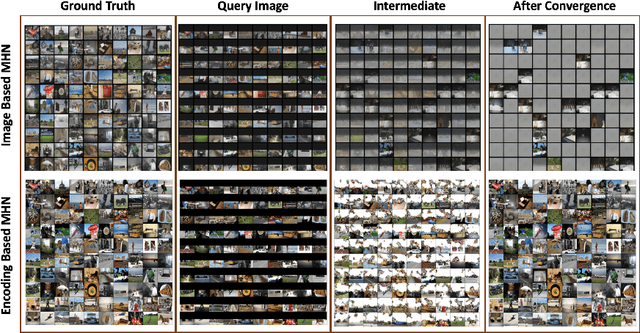

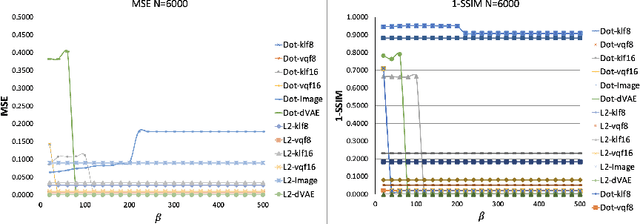
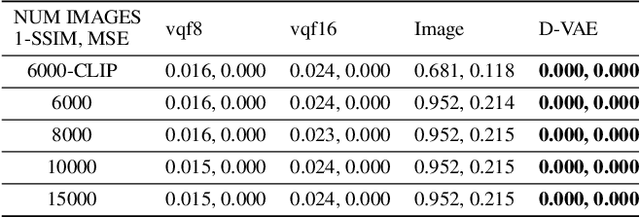
Abstract:Content-addressable memories such as Modern Hopfield Networks (MHN) have been studied as mathematical models of auto-association and storage/retrieval in the human declarative memory, yet their practical use for large-scale content storage faces challenges. Chief among them is the occurrence of meta-stable states, particularly when handling large amounts of high dimensional content. This paper introduces Hopfield Encoding Networks (HEN), a framework that integrates encoded neural representations into MHNs to improve pattern separability and reduce meta-stable states. We show that HEN can also be used for retrieval in the context of hetero association of images with natural language queries, thus removing the limitation of requiring access to partial content in the same domain. Experimental results demonstrate substantial reduction in meta-stable states and increased storage capacity while still enabling perfect recall of a significantly larger number of inputs advancing the practical utility of associative memory networks for real-world tasks.
An Unsupervised Learning Framework Combined with Heuristics for the Maximum Minimal Cut Problem
Aug 16, 2024



Abstract:The Maximum Minimal Cut Problem (MMCP), a NP-hard combinatorial optimization (CO) problem, has not received much attention due to the demanding and challenging bi-connectivity constraint. Moreover, as a CO problem, it is also a daunting task for machine learning, especially without labeled instances. To deal with these problems, this work proposes an unsupervised learning framework combined with heuristics for MMCP that can provide valid and high-quality solutions. As far as we know, this is the first work that explores machine learning and heuristics to solve MMCP. The unsupervised solver is inspired by a relaxation-plus-rounding approach, the relaxed solution is parameterized by graph neural networks, and the cost and penalty of MMCP are explicitly written out, which can train the model end-to-end. A crucial observation is that each solution corresponds to at least one spanning tree. Based on this finding, a heuristic solver that implements tree transformations by adding vertices is utilized to repair and improve the solution quality of the unsupervised solver. Alternatively, the graph is simplified while guaranteeing solution consistency, which reduces the running time. We conduct extensive experiments to evaluate our framework and give a specific application. The results demonstrate the superiority of our method against two techniques designed.
RTFormer: Re-parameter TSBN Spiking Transformer
Jun 20, 2024Abstract:The Spiking Neural Networks (SNNs), renowned for their bio-inspired operational mechanism and energy efficiency, mirror the human brain's neural activity. Yet, SNNs face challenges in balancing energy efficiency with the computational demands of advanced tasks. Our research introduces the RTFormer, a novel architecture that embeds Re-parameterized Temporal Sliding Batch Normalization (TSBN) within the Spiking Transformer framework. This innovation optimizes energy usage during inference while ensuring robust computational performance. The crux of RTFormer lies in its integration of reparameterized convolutions and TSBN, achieving an equilibrium between computational prowess and energy conservation.
Self-Regulated Data-Free Knowledge Amalgamation for Text Classification
Jun 16, 2024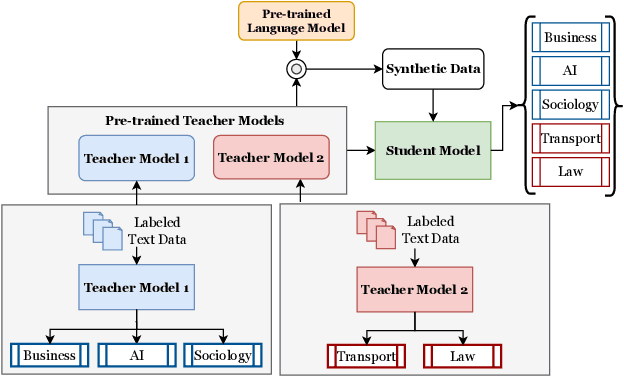
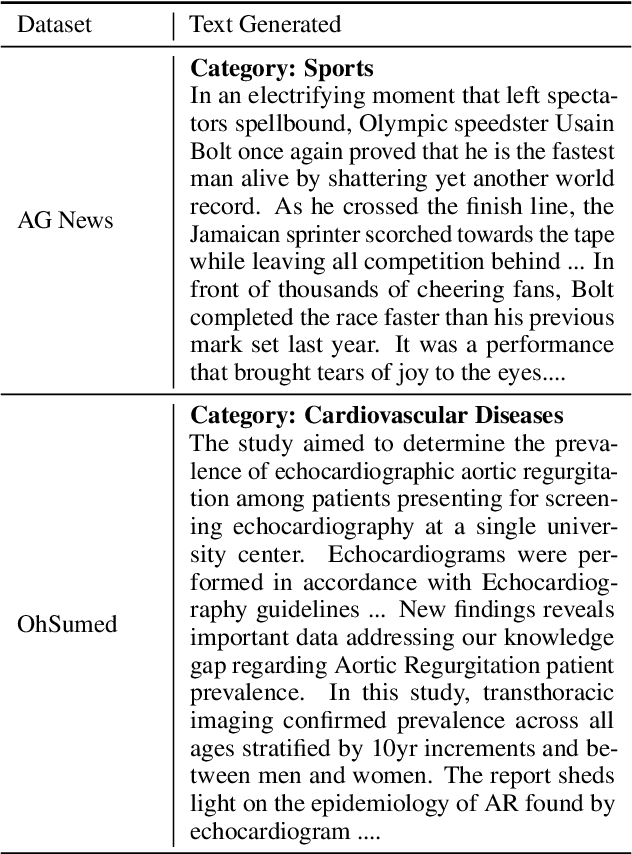
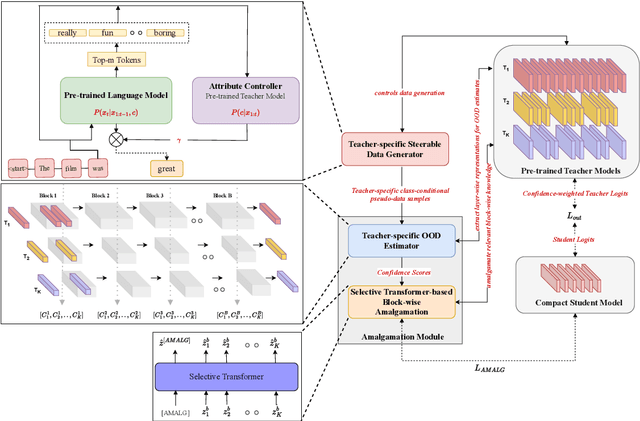
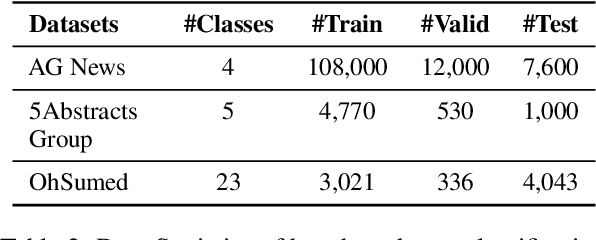
Abstract:Recently, there has been a growing availability of pre-trained text models on various model repositories. These models greatly reduce the cost of training new models from scratch as they can be fine-tuned for specific tasks or trained on large datasets. However, these datasets may not be publicly accessible due to the privacy, security, or intellectual property issues. In this paper, we aim to develop a lightweight student network that can learn from multiple teacher models without accessing their original training data. Hence, we investigate Data-Free Knowledge Amalgamation (DFKA), a knowledge-transfer task that combines insights from multiple pre-trained teacher models and transfers them effectively to a compact student network. To accomplish this, we propose STRATANET, a modeling framework comprising: (a) a steerable data generator that produces text data tailored to each teacher and (b) an amalgamation module that implements a self-regulative strategy using confidence estimates from the teachers' different layers to selectively integrate their knowledge and train a versatile student. We evaluate our method on three benchmark text classification datasets with varying labels or domains. Empirically, we demonstrate that the student model learned using our STRATANET outperforms several baselines significantly under data-driven and data-free constraints.
IntraMix: Intra-Class Mixup Generation for Accurate Labels and Neighbors
May 02, 2024



Abstract:Graph Neural Networks (GNNs) demonstrate excellent performance on graphs, with their core idea about aggregating neighborhood information and learning from labels. However, the prevailing challenges in most graph datasets are twofold of Insufficient High-Quality Labels and Lack of Neighborhoods, resulting in weak GNNs. Existing data augmentation methods designed to address these two issues often tackle only one. They may either require extensive training of generators, rely on overly simplistic strategies, or demand substantial prior knowledge, leading to suboptimal generalization abilities. To simultaneously address both of these two challenges, we propose an elegant method called IntraMix. IntraMix innovatively employs Mixup among low-quality labeled data of the same class, generating high-quality labeled data at minimal cost. Additionally, it establishes neighborhoods for the generated data by connecting them with data from the same class with high confidence, thereby enriching the neighborhoods of graphs. IntraMix efficiently tackles both challenges faced by graphs and challenges the prior notion of the limited effectiveness of Mixup in node classification. IntraMix serves as a universal framework that can be readily applied to all GNNs. Extensive experiments demonstrate the effectiveness of IntraMix across various GNNs and datasets.
 Add to Chrome
Add to Chrome Add to Firefox
Add to Firefox Add to Edge
Add to Edge